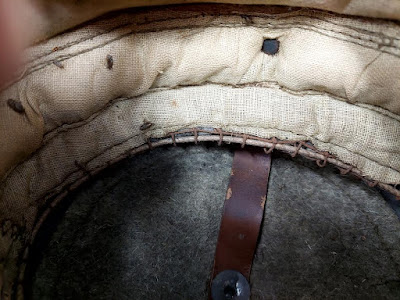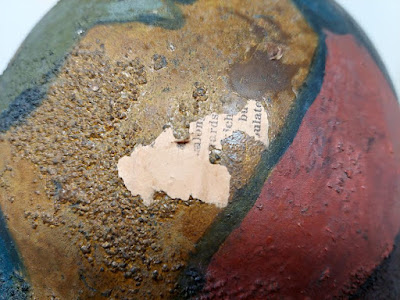First things first. I know of no instances where US troops utilized camouflaged helmets during the Great War; such helmets, as the one in this post, were painted after the hostilities were over.
This is a nice British-made Brodie helmet issued to US troops, a stop-gap practice while America was still ramping up for war-time production.
Reddish/orange, brown, three shades of green, yellow, blue, and black with painted foliage comprise the decoration of this helmet. These imaginative designs were inspired by the similar designs that were mandated on German helmets in the final year of the war.
The Army tried to proscribe practice, but the returning doughboys seemed to generally disregard that order.
Then, the Army changed its mind, somewhat.
Chris Armold, in his wonderful, and nearly comprehensive book, Painted Steel discusses this in length, and was a primary source for much of this information.
Here are some details of this helmet.
Headband spacers are short lengths of rubber tubing, which provided some resilience if the helmet is struck.
British-made Mk I helmets have several characteristics which distinguish them from the nearly identical American-made m.1917. Including the joinery of the rim in the rear of the helmet. Note how the two ends are lapped over one another, whereas the American rim is joined with a butt-joint.
American m.1917 rim seam.
Similarly, the Mk. utilizes split-pins to affix the chinstrap loops...
the m.1917 uses rivets.
The chinstrap and suspension of both the Brodie and the Mk.I are overly-complicated and poorly engineered. That strap in the very dome of the helmet holds it all together, and if that thin strip of leather were to break, the entire assembly will fall out. That will be remedied in both successors of these models - the mk.II and the m.1917A1. The profile of both later helmets was identical to that of the earlier models.
Attempts are made at providing cushioning.
A tiny fragment of newspaper is pasted to the front, but the words are not discernable.
This image also provides a nice view of the anti-reflective, sand, substrate. Where the British usually used sand, generally, American helmets used sawdust to achieve anti-glare properties.
The blue somewhat surprised me. I haven't seen that hue on other "camouflaged" American helmets.
The leather chinstrap is robust, as is the brass buckle. Generally, the buckle on the American helmet is steel.
The leaves are simple, yet imaginative.
At the bottom of it all was the influence of the camouflaged German helmets. Apparently the Americans were very taken with that idea. An interesting difference was that, in the final year of the Great War the Germans were officially ordered to camouflage their helmets, but it was quite the opposite for the Americans.
I acquired this helmet two years ago, when a privately-owned museum was thinning its collection.
I'm very fortunate to have such a lovely example.
Thanks for stopping by.
I'll see you next time with another cool helmet from the collection.
Mannie











.png)

.png)










No comments:
Post a Comment
Your comments are welcome and you can always email me at manniegentile@gmail.com with comments, questions, or corrections.